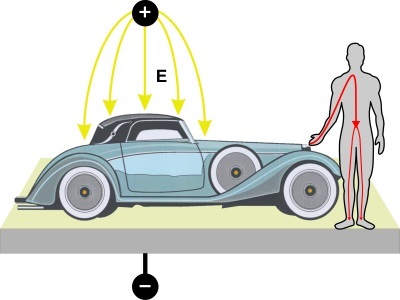Indirect effects
Aside from the direct effects of static and extremely low frequency electric fields (Static fields (0 Hz), Low frequency (0.1 Hz–1 kHz)), indirect effects can occur in electroconductive objects (e.g. vehicles, large work machines, metal fences) due to the created surface charges. The electrical charge increases with the increasing strength of the external electric field and the increasing isolation of the object against the ground. Charging effects can also occur without an external electric field via a static charge caused by friction between different materials (e.g. when taking off a pullover or while walking over floor carpets; at moving parts of machines, vehicles or technical plants in the work area). Perceptible electrical discharges (spark discharges) can occur when approaching charged objects (or grounded objects in the case of humans being charged themselves – example: touching a door handle). When touching charged objects, a current can flow through the body into the ground (contact current or touch current, see Figure). The potency of these effects depends, among others, on the electric field strength, the position of the chargeable object within the field, the size of the object, the strength and duration of the contact current and the grounding of the human body (corresponding to the shunt resistance to the ground).
In everyday life, the provoked indirect effects usually manifest themselves only as harmless perceptions of electrostatic charging or spark discharges. However, especially in the case of high field strengths and/or sufficiently large charged objects in the work area, there is the possibility of the threshold values being exceeded with the risk of permanent adverse health effects caused by involuntary muscle contractions or burns. Occupational safety regulations and measures are intended to prevent such accidents (cf. BMAS, p. 7 f. and 25 ff.; Limit values in Germany (occupational exposure), Table “Permissible contact currents and contact voltages“).
Indirect effects caused by discharge currents can also occur in the radiofrequency band up to 110 MHz (cf. Radio frequency (10 MHz–300 GHz) and Indirect effects). Beside these biological effects, interferences with electronic appliances and components are possible as well.

Corona and the generation of air ions
Charged (“ionized”) air molecules and aerosols (i.e. a colloid of fine solid particles or liquid droplets in the air) are a separate topic in the discussion about the health effects of power lines (alternating current and direct current). The air ions are produced in the so-called corona zone (a region with a partial electrical breakdown in the air) in an area several centimeters from the power line. The ionized air molecules, also called corona ions, occur during normal operation directly at the current-carrying power lines via corona discharge processes. Clouds of electrically charged air molecules (space charge clouds) can be drifted sideways by the wind. This effect is remarkably more pronounced with direct current power lines (HVDC) than with alternating current power lines because of the continuous charge reversal of the alternating current neutralizes the ionized molecules faster. Thus, only direct current overhead power lines can cause a significant drifting effect. Additionally, air pollutants (e.g. ozone, nitric oxide) can be generated by the formation of free radicals near the corona. Those air pollutants are normally neutralized very quickly by chemical reactions or by binding to other air substances and hence, their range is hindered. Corona discharges at power lines can become noticeable – more pronounced in wet weather – by humming, clicking and buzzing noises, which can cause disturbances and nuisance in the adjacent residential area depending on the sound volume.